 I’ve reviewed a lot of Kemco games in the last couple of years here at TouchArcade, and while the quality varies wildly, I can easily say my least favorite of that two dozen, give or take, was Shelterra The Skyworld ($3.99). It basically encapsulated everything that I dislike about developer Magitec’s games. The archaic engine with its jerky scrolling, the localization so stiff you could iron a shirt on it, the irritating dungeons that have you doubling back and forth hitting switches with damage floors everywhere, the asinine approach to character development, and more all added up to one sad little reviewer. Every time I see Magitec’s name on a new Kemco release now, I take a deep breath, flinching the way one would when a static shock is expected from a touch.
I’ve reviewed a lot of Kemco games in the last couple of years here at TouchArcade, and while the quality varies wildly, I can easily say my least favorite of that two dozen, give or take, was Shelterra The Skyworld ($3.99). It basically encapsulated everything that I dislike about developer Magitec’s games. The archaic engine with its jerky scrolling, the localization so stiff you could iron a shirt on it, the irritating dungeons that have you doubling back and forth hitting switches with damage floors everywhere, the asinine approach to character development, and more all added up to one sad little reviewer. Every time I see Magitec’s name on a new Kemco release now, I take a deep breath, flinching the way one would when a static shock is expected from a touch.
Grace Of Letoile ($3.99), as static shocks go, is not a very strong one. It’s a little zap, nothing worse. It carries most of the problems that any Magitec game does, of course. I don’t expect this particular tiger to change its stripes anytime soon. But those dissonant honks aren’t quite as bad this time around, and the good points are a little better than usual. I wouldn’t call this Magitec’s best work, but it’s probably not far from it. The bad things you should expect include that awful old engine doing its best to make you nauseous when it scrolls in any direction, an awkward localization that reads far too literally, and fairly weak dungeons. As usual for this developer, there is also important story content locked in a special in-game shop that you’ll likely need to spend real money to get at.

If you can grit your teeth through that, you’ll find a surprisingly good plot with lots of interesting twists and turns, a thoughtful and unusual battle system, and a satisfying method of customizing your characters. The main hook is the story, which sees heroic orphan Vedley and his sister Moniya chasing down legendary artifacts to try to change the past. The story goes for a bit of a Highlander vibe. Magical dolls called Letoiles are scattered around the world, and if all of their cores are collected by any one of them, it will gain the power to grant any wish. The dolls cannot move on their own, and need to be bound and powered by the soul of a human. Vedley binds himself to a particularly prickly one named Ajin, and sets off to find and destroy the remaining Letoiles, because there can be only one.
Grace of Letoile benefits from a somewhat larger cast than the usual Magitec affair. While the developer seems to enjoy setting their heroes against the entire world with only a sassy sidekick to bounce off of, this game has several characters Vedley can bounce off of. Most of his interactions are still with his sassy sidekick, but it’s a considerably less dour game than we usually see from this developer. It’s still pretty dark in its own ways, however, so if you’ve enjoyed the somewhat brutal tales seen in Magitec’s other games, you’ll get your fill here. The Highlander plot is a good one, enough to power several seasons of Canadian-made TV, allowing rivals to be decent people with goals just as worthy as yours, rather than mustache-twirling villains. There are a couple of those, mind you. It’s also a great concept to milk for some cheap melodrama, and if nothing else, Magitec is pretty good at wringing out every last drop. The translation lets it down a bit, as usual, coming off like it was handled by someone who absolutely couldn’t care less about what they were doing, but it’s more dull than unintelligible, so I guess we should be happy for small favors.
The battle system is a little hard to explain, but let me give it a swing. First of all, it’s turn-based, and unlike their last RPG, Dead Dragons ($3.99), it’s essentially in the traditional style, with one side lining up on the right and the other on the left. Turn order is displayed in a bar at the side of the screen, and various spots on the meter will activate a reward or penalty for whichever participant occupies it, be they friend or foe. You can usually only influence who falls where by removing someone from the equation, hopefully an enemy. You can, however, make limited use of something called the Chronos Gauge, which allows you to interrupt an action or use a special move, both of which can disrupt the order of turns. The gauge itself resembles a clock, with numbers from one to twelve on its face. Each turn taken advances the clock by one hour, and performing special moves that synchronize with the current hour contribute greatly to refilling the gauge. You can also add to the gauge with regular attacks, but they only fill a little bit. You’ll have to plan out your special attacks well if you want to make use of the Chronos Gauge often.

That naturally leads us into the character customization aspects. Special moves are contained in gems that you have to equip to characters in order to use. Each character has a plate that these special gems can be fit into, which like the Chronos Gauge also resemble clocks. Wherever you assign a gem to becomes that skill’s number for the purposes of refilling the Chronos Gauge in battle. Initially, you’re limited in the number of slots you can access, but leveling up allows you to open and make use of new locations on the clock in whatever order you’d like. Leveling itself is also a bit weird in this game. Individual characters don’t level up. Instead, the party itself has a level. It’s pretty weird, but it does avoid the trap of having new characters joining the group and being completely out of synch with your existing members. Not that new members joining your group is a very common occurrence in Kemco games, but I appreciate the sentiment, anyway.
I kind of like how both the combat gimmicks and the character customization actually tie together in a meaningful way. Since the Chronos Gauge moves forward in a dependable way, you can plan for when you want to use certain special moves by how likely they’ll coincidence with the hour the clock is currently showing. So, for example, you probably don’t want to equip healing magic on the first few spots of the clock, since you’re very unlikely to need early on in a battle. It comes unglued a little in longer fights, but for the majority of battles, the choices you make have a genuine effect on how quickly they wrap up. Sadly, boss fights tend to come down to the usual business of pouring out special moves as quickly as possible and healing whenever needed. The boss battles are too long to try to synchronize with the Chronos Gauge, and it empties pretty quickly without you doing that.
I just wish the other aspects of the game worked as well as all of that. The dungeons are still terrible. They’re long, unpleasant, and full of too many winding roads that lead to useless treasure. Magitec really needs to learn to more frequently place treasure that makes it feel like it was worth the trip to get to it. The overall structure of the game is quite repetitive, too. Even if it doesn’t make sense sometimes from a narrative point of view, the game rigidly follows a town to dungeon to town set-up, only occasionally feeling natural in the way it leads the characters around. While I enjoy the plot, the dialogue itself is pretty rough thanks to the dry work done on the English script. Characters have a tendency to drone on well past the point that anyone wants them to, and with the clumsy way everything is phrased, you’ll probably find yourself hammering on the screen to skip its seventh reiteration of whatever point it was trying to make. I also don’t care for this developer’s practice of putting story behind a paywall. You can grind out the points to earn those dungeons on your own without paying, but a single playthrough will leave you with nowhere near enough to do so.

Also, this game engine needs to be ditched, in no uncertain terms. Everyone else under Kemco’s umbrella has moved on except Magitec. This frankly terrible performance was annoying enough three years ago, but there’s no excuse for such modest games to run so badly on today’s hardware. I understand that part of the reason these RPGs are tenable in today’s App Store market is that they heavily reuse assets and crank the games out quickly, and making a new engine is pretty much the opposite of both of those things, but it really needs to be done sooner or later. Until then, we’re going to have to deal with the fidgety navigation controls, a clunky UI designed more for a numeric keypad than touch, and the blurry lurching of the screen every time you move your character. Well, at least there are Game Center achievements, a rarity in Kemco games. Don’t read the list unless you want some light spoilers, though.
If you’re looking for your monthly JRPG fix, Grace Of Letoile will hold you over, and it won’t even be unpleasant about it most of the time. It has a lot of interesting ideas that fans of the genre might find interesting to play around with, and the story is pretty decent, even if the dialogue belongs in la toilette. If you’re even slightly weary with the whole JRPG idea, I’d steer clear of Grace Of Letoile, though. While its plot is unusual and its specific mechanics are unique, the overall trappings are about what you would expect at this point from the Kemco assembly line. As is typical for this developer in particular, it’s a frustrating mix of clever ideas and sloppy execution.